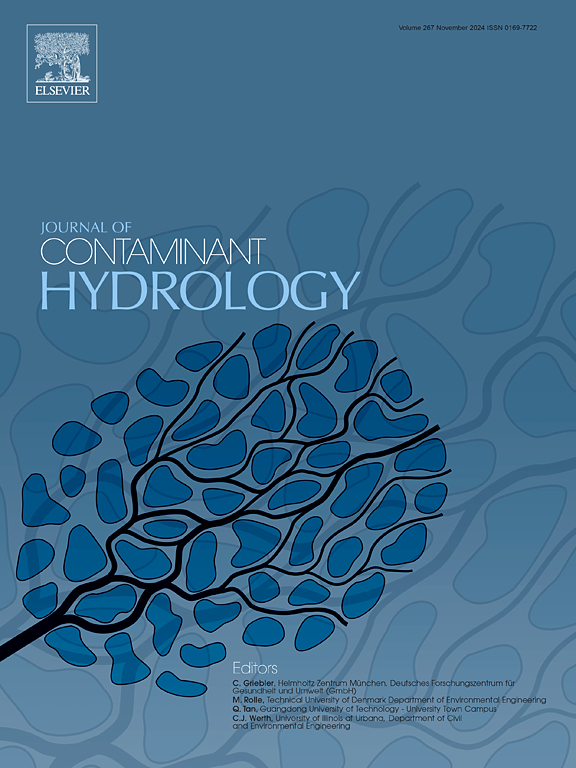Geochemical processes and sensitivity analysis of flow velocity and column depth for effective nickel removal
IF 3.5
3区 环境科学与生态学
Q2 ENVIRONMENTAL SCIENCES
引用次数: 0
Abstract
Eliminating heavy metals from the environment is crucial, even in low concentrations, due to their high toxicity, persistence, and tendency to accumulate in living organisms, posing serious threats to human health and ecosystems. This study investigates the geochemical processes that govern nickel (Ni) removal in Filtralite and evaluates how different parameters influence its effectiveness. The interaction between contaminated water and Filtralite-forming minerals results in a rapid increase in pH, leading to the immediate precipitation of teophrastite (Ni(OH)2) at the initial filtration stages. However, as water continues to interact with Filtralite, its capacity to maintain high pH levels declines over time, reducing the Ni removal efficiently. In regions with a Mediterranean climate and considering an infiltration system that manages runoff from 10 % of the urban landscape, a filter layer of 200 mm combined with flow velocities below 828 mm/h has been found to optimize metal retention. Under these conditions, more than 90 % of the filter's total Ni-holding capacity is effectively used, and replacement is expected to be necessary roughly every three years. Additionally, tests simulating intense rainfall confirm that the eliminated Ni remains securely bound within the filter media, reinforcing Filtralite's reliability as a filtration material for infiltration systems. This research contributes to a better understanding of the geochemical mechanisms involved in metal removal and lays the groundwork for future design considerations in Filtralite-based filtration applications.

有效除镍的地球化学过程及流速和柱深敏感性分析
从环境中消除重金属至关重要,即使浓度很低,因为它们具有高毒性、持久性和倾向于在生物体中积累,对人类健康和生态系统构成严重威胁。本研究探讨了控制滤液中镍(Ni)去除的地球化学过程,并评价了不同参数对其去除效果的影响。受污染的水与滤石形成矿物之间的相互作用导致pH值迅速升高,导致在过滤初始阶段立即析出铁辉石(Ni(OH)2)。然而,随着水继续与滤石相互作用,滤石维持高pH值的能力随着时间的推移而下降,从而降低了Ni的有效去除。在地中海气候的地区,考虑到渗透系统可以管理10%的城市景观径流,200毫米的过滤层与低于828毫米/小时的流速相结合,可以优化金属潴留。在这些条件下,过滤器总持镍能力的90%以上得到有效利用,预计大约每三年更换一次。此外,模拟强降雨的测试证实,去除的Ni仍然安全地结合在过滤介质中,从而增强了Filtralite作为渗透系统过滤材料的可靠性。这项研究有助于更好地理解金属去除的地球化学机制,并为未来基于滤石的过滤应用的设计考虑奠定基础。
本文章由计算机程序翻译,如有差异,请以英文原文为准。
求助全文
约1分钟内获得全文
求助全文
来源期刊

Journal of contaminant hydrology
环境科学-地球科学综合
CiteScore
6.80
自引率
2.80%
发文量
129
审稿时长
68 days
期刊介绍:
The Journal of Contaminant Hydrology is an international journal publishing scientific articles pertaining to the contamination of subsurface water resources. Emphasis is placed on investigations of the physical, chemical, and biological processes influencing the behavior and fate of organic and inorganic contaminants in the unsaturated (vadose) and saturated (groundwater) zones, as well as at groundwater-surface water interfaces. The ecological impacts of contaminants transported both from and to aquifers are of interest. Articles on contamination of surface water only, without a link to groundwater, are out of the scope. Broad latitude is allowed in identifying contaminants of interest, and include legacy and emerging pollutants, nutrients, nanoparticles, pathogenic microorganisms (e.g., bacteria, viruses, protozoa), microplastics, and various constituents associated with energy production (e.g., methane, carbon dioxide, hydrogen sulfide).
The journal''s scope embraces a wide range of topics including: experimental investigations of contaminant sorption, diffusion, transformation, volatilization and transport in the surface and subsurface; characterization of soil and aquifer properties only as they influence contaminant behavior; development and testing of mathematical models of contaminant behaviour; innovative techniques for restoration of contaminated sites; development of new tools or techniques for monitoring the extent of soil and groundwater contamination; transformation of contaminants in the hyporheic zone; effects of contaminants traversing the hyporheic zone on surface water and groundwater ecosystems; subsurface carbon sequestration and/or turnover; and migration of fluids associated with energy production into groundwater.
 求助内容:
求助内容: 应助结果提醒方式:
应助结果提醒方式:


